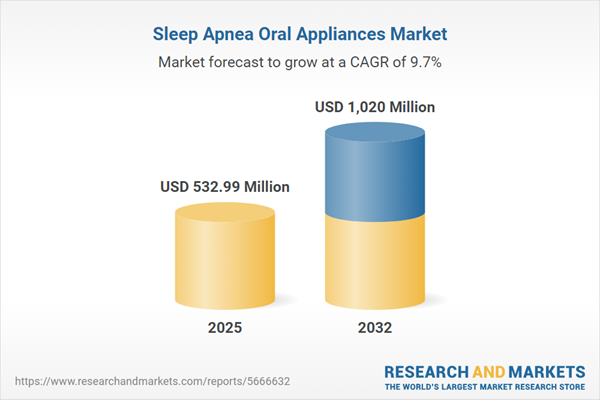Speak directly to the analyst to clarify any post sales queries you may have.
The sleep apnea oral appliances market is undergoing dynamic change, driven by technology and shifting healthcare standards, as industry stakeholders look for clinically proven, cost-efficient solutions for a growing patient base.
Market Snapshot of the Sleep Apnea Oral Appliances Market
The Sleep Apnea Oral Appliances Market grew from USD 489.75 million in 2024 to USD 532.99 million in 2025. It is expected to continue growing at a CAGR of 9.71%, reaching USD 1.02 billion by 2032.
Fueled by increased clinical acceptance and demand for alternatives to traditional sleep therapies, the sector is seeing robust expansion across established and emerging regions. Ongoing reimbursement reforms and product innovations are strengthening the position of oral appliances among both physicians and patients seeking long-term, user-friendly therapy options.
Scope & Segmentation of the Study
This market research comprehensively covers trends and growth drivers for decision-makers evaluating opportunities in the sleep apnea oral appliances industry. The report analysis includes:
- Product Types: Mandibular advancement devices and tongue-stabilizing devices, each targeting specific anatomical needs and patient profiles.
- Purchase Pathways: Online over-the-counter oral appliances and physician-prescribed/customized solutions, reflecting varied consumer preferences and treatment requirements.
- Age Groups: Above 60 years, 40-60 years, and below 40 years, emphasizing differing healthcare priorities and adoption motives.
- Distribution Channels: Hospital pharmacies & dental clinics, online pharmacies, and retail pharmacies, measuring the impact of direct-to-consumer and clinician-led models.
- End Users: Home care settings/individuals and hospitals, highlighting trends in self-managed versus integrated clinical care.
- Regional Markets: Americas, Europe, Middle East & Africa, Asia-Pacific; analysis extends to prominent sub-regions and countries within each, such as North America (United States, Canada, Mexico), Latin America (Brazil, Argentina, Chile, Colombia, Peru), Western Europe (United Kingdom, Germany, France), Middle East (UAE, Saudi Arabia, Turkey), Africa (South Africa, Egypt, Kenya), and Asia-Pacific (China, Japan, India, Australia, Indonesia).
- Technological Advances: Adoption of 3D printing, digital scanning, remote monitoring, and biocompatible polymers that are shaping next-generation device production and patient management.
Key Takeaways for Senior Decision-Makers
- Adoption and patient access remain uneven across geographies and age segments, often influenced by reimbursement policies and clinician expertise.
- Ongoing innovation—especially modular design, digital fittings, and telehealth integrations—creates differentiation opportunities for both incumbents and new entrants.
- Strategic alliances among manufacturers, dental clinics, and digital health startups are expanding the industry’s service capabilities and supporting patient adherence.
- OTC channels are gaining traction, particularly in emerging economies where public health constraints and cost-sensitivity drive patients toward accessible alternatives.
- Customized distribution and marketing strategies aligned to local healthcare infrastructure, regulatory frameworks, and consumer needs increase the likelihood of successful market penetration and brand loyalty.
Tariff Impact on Supply Chain and Pricing Strategies
Newly announced tariffs in the United States, coming into effect in 2025, are projected to elevate the cost basis for manufacturers reliant on imported medical device components. This may prompt shifts in procurement tactics, local sourcing, and supply chain reevaluation. Companies with established domestic manufacturing or diversified sourcing may gain competitive advantages, while others could face pricing pressure or need to adjust service offerings to maintain profitability. Ancillary service costs such as digital scanning and telehealth may also be impacted, necessitating bundled or value-focused delivery models to support provider and patient uptake.
Methodology & Data Sources for Market Insights
This report synthesizes a multi-tiered research approach. Secondary data includes analysis of public clinical studies, regulatory documents, industry publications, and patent records, forming the backbone for technology and market mapping. Primary research draws on interviews with industry leaders, healthcare providers, and distributors, supported by quantitative surveys among end users. Triangulation and sensitivity checks ensure findings are robust, validated, and relevant to diverse stakeholder priorities.
Why This Report Matters for Sleep Apnea Oral Appliances
- Enables strategic planning by clarifying technology trends, reimbursement dynamics, and emerging care models across regions and segments.
- Provides actionable benchmarks for evaluating supply chain resiliency, partnership potential, and customer acquisition strategies in the evolving landscape.
Conclusion
The sleep apnea oral appliances market is poised for sustained evolution, with integrated care pathways and digital technologies reshaping stakeholder priorities and growth opportunities. Decision-makers equipped with data-driven insights can confidently navigate this competitive market environment.
Additional Product Information:
- Purchase of this report includes 1 year online access with quarterly updates.
- This report can be updated on request. Please contact our Customer Experience team using the Ask a Question widget on our website.
Table of Contents
3. Executive Summary
4. Market Overview
7. Cumulative Impact of Artificial Intelligence 2025
Companies Mentioned
The companies profiled in this Sleep Apnea Oral Appliances market report include:- Airway Management, Inc.
- Apnea Sciences Corporation
- AVEOtsd
- BMC Medical Co., Ltd.
- Braebon Medical Corporation
- Dream Systems Dental Sleep Laboratory
- DynaFlex
- Great Lakes Dental Technologies
- James R. Glidewell Dental Ceramics, Inc.
- MicroDental Laboratories
- Myerson LLC
- Open Airway Dental Solutions Ltd
- OravanOSA
- Panthera Dental Inc.
- ProSomnus, Inc.
- ResMed Inc.
- SomnoMed Limited
- Tomed GmbH
- Vivos Therapeutics, Inc.
Table Information
| Report Attribute | Details |
|---|---|
| No. of Pages | 182 |
| Published | November 2025 |
| Forecast Period | 2025 - 2032 |
| Estimated Market Value ( USD | $ 532.99 Million |
| Forecasted Market Value ( USD | $ 1020 Million |
| Compound Annual Growth Rate | 9.7% |
| Regions Covered | Global |
| No. of Companies Mentioned | 20 |









